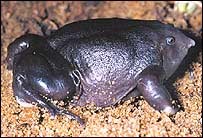SLIMY SOULS
-Shivani Thakur
The Western Ghats of India are as rich in bio diversity as the Amazonian basin.
The variety of flora and fauna is as exotic as those found elsewhere in the tropical rainforests of the world.
Of all the animals found in the ghats; amphibians are rarely given a thought. They are looked down by us and generally referred as icky, slimy creatures not worth the mention. Their existence or lack of it is hardly a concern for us.
Yet, an environmental researcher would always take interest in their population, how they sustain themselves.
Amphibians form three types of orders namely Caecilians, frogs and toads, and salamanders and newts.
The Ghats are considered a hot spot of amphibian diversity. S.D.Biju,
a conservation biologist at the Tropical Garden Research Institute at Palode, Kerala,
along with Franky Bossuyt ,an evolutionary geneticist at the Brussels Free University in Belgium have recently made a “once-in-a century “ find reported in the Nature magazine.
S.D.Biju discovered a three- inch long purple snub- nosed frog. This frog is not only a new species but also a new family of frogs altogether. Its internal anatomy and DNA sequence, done by Franky Bossuyt, shows it belongs to a
species that existed in the age the dinosaurs. Its closest relatives now live in Seychelles, 3000 km south of the Indian peninsula, providing another piece of evidence in the theory of continent drift
 S.Blair Hedges, in the section of news &views of
Nature magazine describes it as a ‘once in a century’
find because only 29 families of frogs are known, encompassing the approximately 4,800 species. The last discovery of any species of frogs belonging to a new family was in 1926.
Earliest by mid 1800s, most of these families had been named. Dr.Biju, a botanist, is an authority on frogs.
His interest in frogs was sparked by the many odd specimens of frogs he encountered during his botanical surveys in the Western Ghats forests.
His recent synopsis of the fog fauna of the Western Ghats mentions four new genera and about 115 new species awaiting scientific description. This purple colored frog, Nasikabatrachus sahyadrenis, maybe rare but is widely distributed in forests of Western
Ghats and plantations of Kerala and Tamil Nadu.
S.Blair Hedges, in the section of news &views of
Nature magazine describes it as a ‘once in a century’
find because only 29 families of frogs are known, encompassing the approximately 4,800 species. The last discovery of any species of frogs belonging to a new family was in 1926.
Earliest by mid 1800s, most of these families had been named. Dr.Biju, a botanist, is an authority on frogs.
His interest in frogs was sparked by the many odd specimens of frogs he encountered during his botanical surveys in the Western Ghats forests.
His recent synopsis of the fog fauna of the Western Ghats mentions four new genera and about 115 new species awaiting scientific description. This purple colored frog, Nasikabatrachus sahyadrenis, maybe rare but is widely distributed in forests of Western
Ghats and plantations of Kerala and Tamil Nadu.
Another amphibian variety has been discovered in the Ghats. According to
Current Science the number of species of caecilian (limbless) amphibians is growing rapidly. There has been a remarkable increase of 57 per cent in caecilian amphibian diversity over past eight years. Most of them have been found to inhabit gardens
or plantations yet gone unnoticed by the scientists. The intrinsic biology of caecilian makes their study challenging. The Indian caecilian amphibian burrows the soil and special digging effort is needed to bring it out. These findings suggest a need for more
biotic surveys of this region and application of modern techniques such as molecular analysis to aid the search for new amphibian species. More so because they are the best indicators overall of environmental health. Their porous skin allow for water transpiration
and movement of chemicals. Amphibians drink and breathe through their skins so if anything happens to their skin it starts affecting them. If the third of world’s amphibian species is facing extinction it is because of loss of habitat, to pollution, climate
changes and increasing competition with humans. Their deaths could be an indicator of the poor state of our environment.
( Photo courtesy: BBC News)